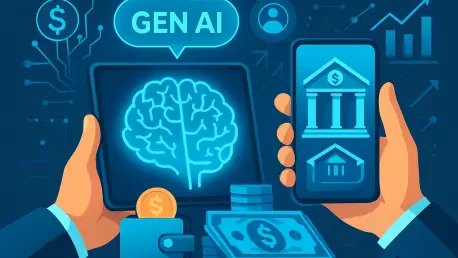In an era where technological advancements are reshaping industries at an unprecedented pace, the banking sector stands at the forefront of a transformative wave driven by Generative AI (GenAI). This cutting-edge technology is not merely an upgrade but a revolutionary force, redefining how financial institutions operate, interact with customers, and navigate complex regulatory landscapes. GenAI’s ability to create, optimize, and automate processes positions it as a pivotal tool for enhancing efficiency and addressing compliance challenges in a highly digitalized world. This analysis delves into the current trends surrounding GenAI in banking, explores real-world applications, incorporates expert perspectives, and examines the future potential of this technology in shaping the financial services landscape.
The Rise of Generative AI in Banking
Adoption Trends and Growth Statistics
The adoption of GenAI in the financial sector has surged dramatically in recent years, reflecting a broader shift toward digital transformation. According to industry reports from leading analyst firms, the global market for AI in banking is projected to grow at a compound annual growth rate of over 30% from the current year to 2027, with GenAI playing a central role in this expansion. Major banks and financial institutions are allocating substantial budgets to AI technologies, aiming to streamline operations, cut costs by up to 20%, and elevate customer satisfaction through personalized services.
Beyond investment figures, the focus on GenAI is evident in the increasing number of pilot projects and full-scale implementations across the sector. Regulatory bodies are also facilitating this growth by establishing controlled environments for innovation. For instance, the Hong Kong Monetary Authority (HKMA) has introduced the GenAI Sandbox, a platform that allows banks to test AI solutions under strict oversight, ensuring safety while fostering creativity. Such initiatives underscore the industry’s commitment to balancing innovation with stability.
This trend is not merely about numbers but also about strategic intent. Financial institutions recognize that GenAI can address long-standing inefficiencies, from manual processing to risk assessment, making adoption not just a choice but a competitive necessity. The momentum seen in current adoption rates suggests that GenAI is poised to become a cornerstone of banking operations in the near term.
Real-World Applications and Case Studies
GenAI is already making tangible impacts in banking through innovative applications that solve real-world problems. A notable example is the collaboration between CLPS Incorporation and The Bank of East Asia (BEA) in the HKMA’s GenAI Sandbox. Their joint Proof-of-Concept (PoC) for Nibot, an AI agent integrating GenAI with Robotic Process Automation (RPA), showcases how technology can revolutionize financial workflows. Nibot’s features include intelligent process optimization that embeds regulatory compliance, automated risk monitoring for real-time threat detection, and AI-driven verification through multi-agent collaboration, setting a new standard for efficiency.
Elsewhere, GenAI is being leveraged for diverse purposes that enhance both operational and customer-facing aspects of banking. Several leading institutions have deployed AI-powered chatbots to provide 24/7 customer support, drastically reducing response times and improving user experiences. Additionally, fraud detection systems powered by GenAI analyze vast datasets to identify suspicious patterns with unprecedented accuracy, safeguarding assets and trust.
Another compelling application lies in personalized financial advice, where GenAI algorithms tailor recommendations based on individual customer data, fostering deeper engagement. These examples illustrate the versatility of GenAI, demonstrating its capacity to address a spectrum of challenges from backend automation to frontline service delivery. As more institutions witness these successes, the drive to implement similar solutions continues to grow.
Expert Opinions on GenAI’s Impact in Banking
Insights from industry leaders highlight the transformative potential of GenAI while acknowledging the hurdles that accompany such innovation. Robin An, Vice President at CLPS, has emphasized the efficiency gains from tools like Nibot, noting their ability to streamline complex processes. Similarly, Raymond Lin, CEO of CLPS, points to intelligent risk control as a key benefit, while Mourice Pang, Head of Fintech Development at BEA, underscores the importance of compliance integration in maintaining operational integrity.
Analysts and thought leaders echo these sentiments, often citing GenAI’s role in advancing risk management and digital transformation. However, they also caution against challenges such as data privacy risks and ethical dilemmas surrounding AI decision-making. The consensus is clear: while the technology offers immense promise, it must be deployed with careful consideration of its societal and regulatory implications to avoid unintended consequences.
A recurring theme in expert discussions is the necessity of strategic partnerships between technology providers and financial institutions. Such collaborations ensure that innovation aligns with industry needs and regulatory standards, creating a balanced approach to adoption. This perspective reinforces the idea that GenAI’s success in banking hinges on cooperative efforts that prioritize both progress and responsibility.
Future Outlook for Generative AI in Financial Services
Looking ahead, GenAI is expected to drive even more sophisticated advancements in banking, particularly through hyper-automation of intricate workflows. Deeper integration with RPA could enable end-to-end automation of processes that currently require human intervention, significantly reducing operational costs and enhancing accuracy. This evolution promises to free up resources for strategic initiatives, allowing banks to focus on customer-centric innovation.
The benefits of these advancements are substantial, yet they come with notable challenges. Scalability remains a concern as institutions aim to roll out GenAI solutions across diverse operations, while cybersecurity risks loom large given the sensitivity of financial data. Evolving regulatory frameworks will also demand continuous adaptation to ensure compliance, posing a dynamic test for implementation strategies.
On a broader scale, successful PoCs like Nibot could catalyze widespread adoption, inspiring other regions and institutions to explore similar innovations. This trend may position areas like Hong Kong as leading fintech hubs, where regulatory support and technological experimentation converge to create a fertile ground for growth. The ripple effects of such developments could redefine competitive dynamics in the global banking arena.
Conclusion: Embracing GenAI for Banking’s Future
Reflecting on the journey of Generative AI in banking, it has become evident that this technology has carved a significant niche in enhancing efficiency, bolstering compliance, and refining risk management. Initiatives like the partnership between CLPS and BEA within the HKMA’s GenAI Sandbox stand as testaments to the power of controlled innovation, demonstrating how strategic collaborations can yield groundbreaking results. As the industry moves forward, financial institutions need to prioritize investment in GenAI technologies, forging alliances with tech providers to co-create solutions tailored to emerging needs. Beyond adoption, a focus on robust cybersecurity measures and adaptive regulatory strategies proves essential to safeguard progress. Ultimately, the path ahead demands a proactive stance, encouraging banks to not only embrace GenAI but also champion ethical standards, ensuring that innovation serves as a force for sustainable growth in the financial landscape.









